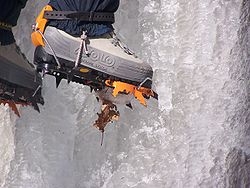
Front pointing
Encyclopedia

Mountaineering
Mountaineering or mountain climbing is the sport, hobby or profession of hiking, skiing, and climbing mountains. While mountaineering began as attempts to reach the highest point of unclimbed mountains it has branched into specialisations that address different aspects of the mountain and consists...
and ice climbing
Ice climbing
Ice climbing, as the term indicates, is the activity of ascending inclined ice formations. Usually, ice climbing refers to roped and protected climbing of features such as icefalls, frozen waterfalls, and cliffs and rock slabs covered with ice refrozen from flows of water. For the purposes of...
which is used to ascend moderate to steep ice slopes. Also referred to as the German technique, it is accomplished through the use of crampons
Crampons
Crampons are traction devices used to improve mobility on snow and ice. There are three main attachment systems for footwear: step-in, hybrid, and strap bindings. The first two require boots with welts, the last adapt to any type....
with two front-slanting points or spikes, which allow traction to be concentrated at the toe of the climber's boots. Climbers generally pick up this technique rather easily as it feels natural and secure but have a tendency to overuse it on moderately angled slopes where an alternate technique called flat-footing (French technique) would be less tiring and just as secure.
Due to the added stress and tiring effect on the calf muscles, climbers who regularly use this technique will wear rigid crampons, or stiff/plastic mountaineering boots, versus the hinged variety used for more general mountaineering on steep snow slopes or glacier
Glacier
A glacier is a large persistent body of ice that forms where the accumulation of snow exceeds its ablation over many years, often centuries. At least 0.1 km² in area and 50 m thick, but often much larger, a glacier slowly deforms and flows due to stresses induced by its weight...
s.

